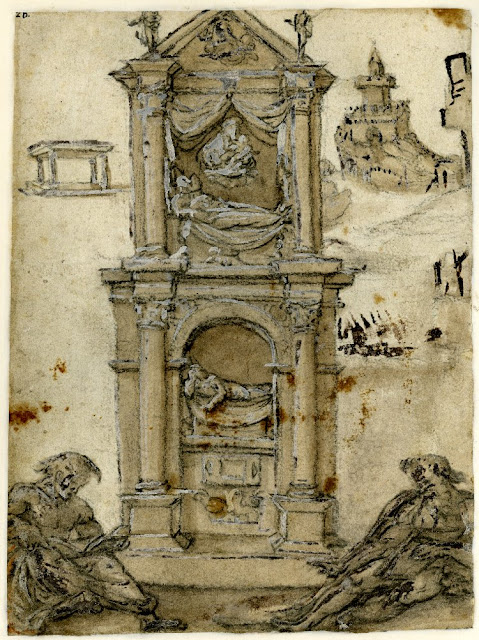 |
| Amico Aspertini Sketchbook Vaulted structures from the antique ca. 1530-40 drawing on paper British Museum |
"According to Bober, one of the ruined vaulted structures may refer to the Baths of Diocletian in Rome."
 |
| Amico Aspertini Sketchbook Left - Ruins of a vaulted structure with exedra Right - One end of a modern church ca. 1530-40 drawing on paper British Museum |
"Bober thinks that the view of the ruins on the left, above the barrel-vaulted structure, is similar to one by Heemskerck representing the ruins where the Trophies of Marius were installed in Rome. There isn't in fact that much in common between the two views, except maybe for the central semicircular exedra. It seems possibly inspired by some of the ruins on the Palatine Hill, or by those in the Baths of Diocletian in Rome. For the building on the right Bober thinks it could have been inspired by the east end of the church of Santa Maria delle Grazie in Milan, but this does not seem convincing."
 |
| Amico Aspertini Sketchbook Circular building set below hills with ruins Classical figures in the foreground ca. 1530-40 drawing on paper British Museum |
 |
| Amico Aspertini Sketchbook Half of a circular building set amidst ruins Classical crowd in the foreground ca. 1530-40 drawing on paper British Museum |
"The scene in the foreground is according to Bober taken from an unidentified historical relief or reverse of a coin. The circular structure in the middle seems a collation between a cross-section of the Pantheon and the Colosseum."
 |
| Amico Aspertini Sketchbook Interior of a Temple Two female figures in foreground ca. 1530-40 drawing on paper British Museum |
 |
| Amico Aspertini Sketchbook Stepped archway ornamented with antique sculpture Three female figures in foreground ca. 1530-40 drawing on paper British Museum |
"A similar archway appears in Aspertini's Adoration of the Shepherds in the Uffizi. Also, as in the painting, a classical torso appears on this drawing. But if the one in the painting can be identified as the Torso Gaddi in the Uffizi, this is not necessarily the case with the one on this sheet, which is instead closer to an untraced male torso recorded by Heemskerck in the cortile of Casa Maffei in Rome circa 1532-37. . . . The two towers at the end of the archway are the symbolic image of Bologna (the Torri Garisenda and degli Asinelli) as they appear in Aspertini's painting of the Entrance of St Petronio in Bologna."
 |
| Amico Aspertini Sketchbook Two-storied tomb Recumbent figures in foreground ca. 1530-40 drawing on paper British Museum |
 |
| Amico Aspertini Sketchbook Figures in architectural settings ca. 1530-40 drawing on paper British Museum |
 |
| Amico Aspertini Sketchbook Group of putti carrying drunken Silenus before a Triumphal Arch ca. 1530-40 drawing on paper British Museum |
"Another example of Mantegna's influence on Aspertini. The figures in the middle foreground are to be seen as an interpretation of the satyrs transporting Silenus in the Bacchanal with Silenus by Mantegna."
 |
| Amico Aspertini Sketchbook Groups of figures set in townscape with ruins ca. 1530-40 drawing on paper British Museum |
"According to Bober, the rough sketches of ruins in the distant background apparently include the Septizonium of Septimius Severus. Groups of figures in the middle and foreground include a praying monk before a crucifix nailed on the wall of a structure on the recto of the following sheet. The lying figure in the front seems related to a river god."
 |
| Amico Aspertini Sketchbook Modern house with loggia Palatine ruins in background Two antique statues in foreground ca. 1530-40 drawing on paper British Museum |
 |
| Amico Aspertini Sketchbook Two elaborate buildings Four figures in foreground ca. 1530-40 drawing on paper British Museum |
"The Amoretto carrying arms at the bottom right corner is similar to some found on bases of candelabra, like for example one found today in the Uffizi in Florence, but once in the della Valle collection in Rome. . . . On the left a female herm and, at the centre, a nude male on a pile of armour striving to break fetters that encircle his arms (inscribed "furore") and a nude male figure pointing to his chest and grasping a bunch of leaves (inscribed "amicia") are representations of contrasting personifications, as observed by Bober. As noted by Martorelli, the building in the background on the right presents festoons hanging at the sides similar to those found on one of the panels [by Aspertini] found in the church of San Girolamo della Certosa in Bologna, and both buildings on this drawing are reminiscent of those illustrated on the panels."
 |
| Amico Aspertini Sketchbook Figure groups before townscape Cornice in foreground ca. 1530-40 drawing on paper British Museum |
"Some of the figures on the right have rather marked features, especially the old bearded man in the middle and the nude sitting on the stone, both looking very wide-eyed towards the woman and child on the left, the former pointing at them, the latter clenching his fist in anger. The apparent narrative has not yet been identified."
 |
| Amico Aspertini Sketchbook Ruins with figures ca. 1530-40 drawing on paper British Museum |
"As noted by Bober, the ruins in the background are likely to refer to the Palatine, including the church of San Teodoro at its feet. [She also] observes that the Liberation of St Peter in the middle ground is after Raphael's tapestry cartoon of the same subject."